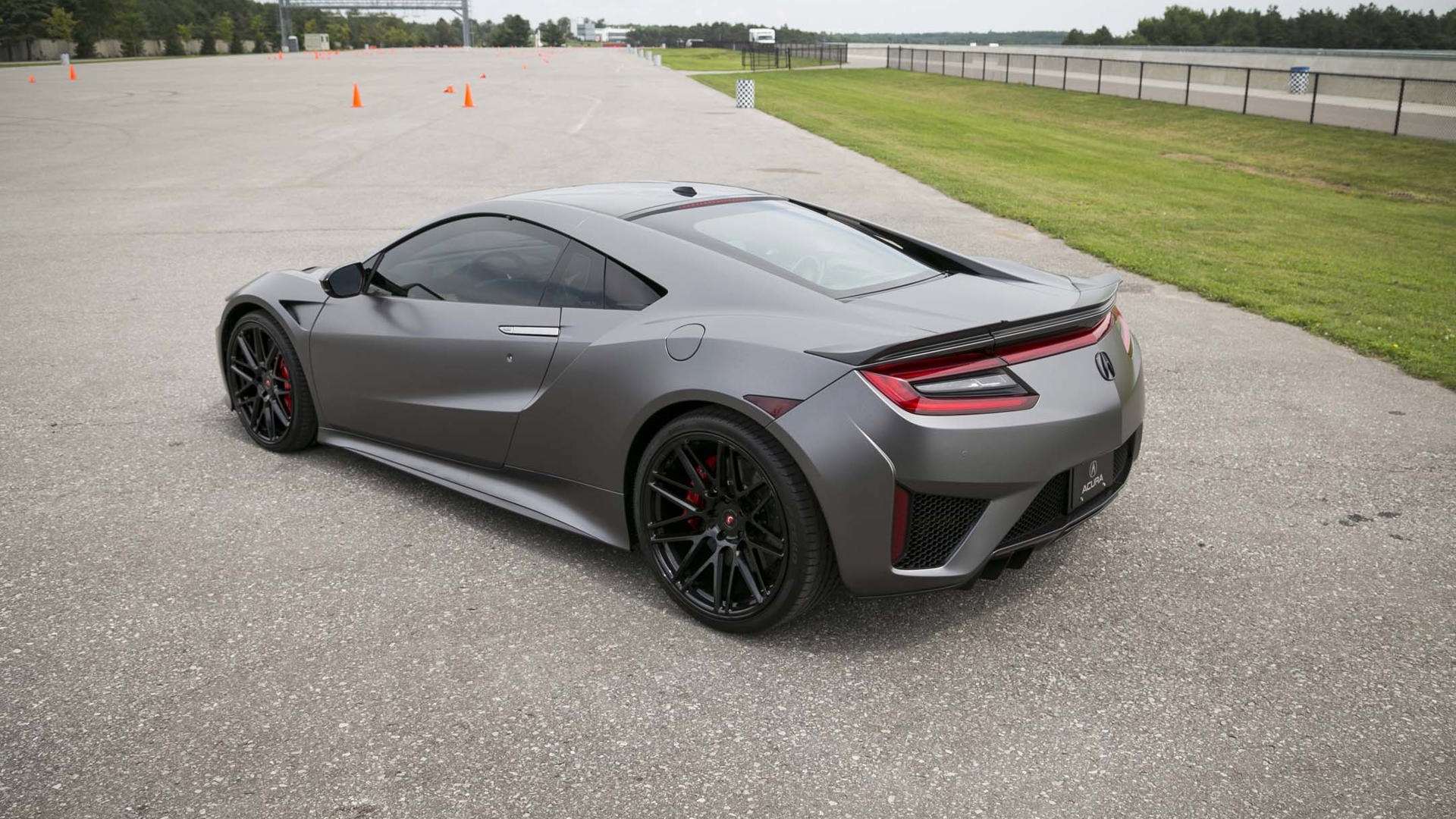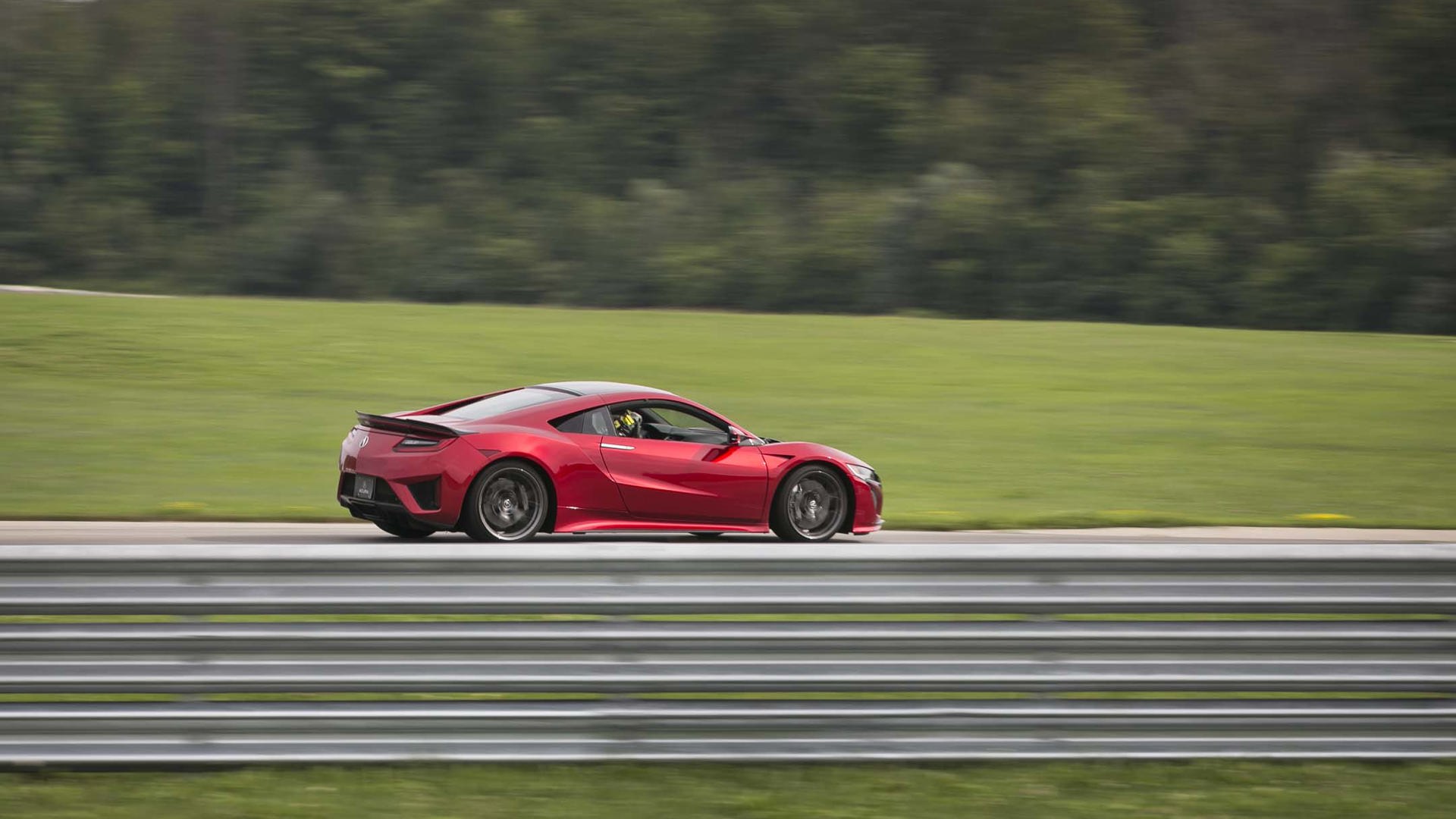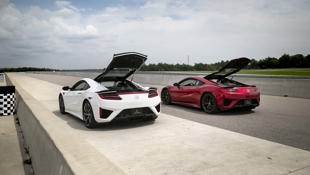True motoring enthusiasts fuel their driving passion by logging seat time in anything considered an enthusiast’s car. And that’s pretty much anything on the road. Do you like raw, angry muscle cars? How about featherweight, precision-honed sports cars? Rough-and-ready off-road beasts? Hell, there’s a Ford Pinto Fan Club on Facebook with over 2,600 members. If it’s drivable, it’s worthy of enthusiasm, I say.
From calm, quiet daily driving – to full-blown, hair-on-fire track weapon.
One car that should be on every driving enthusiast’s must-drive list is Acura’s NSX – the machine that came to market, kicked sand in the faces of out-of-date, quality-be-damned supercar makers and proved that a sexy exotic two-seater could actually be used as a reliable daily driver.
A number of years ago, I was fortunate enough to drive a first-generation NSX. It looked tired and was very well worn, having been abused repeatedly at one of those rent-an-exotic places. And yet, after climbing out of a (newer) Ferrari and into the war-torn Acura, it became clear that the NSX would become a fixture on my wish-to-own list for the rest of my driving days (that Ferrari, meanwhile, not so much).
The Acura was pure and vivacious in the way it went about its business on the road. Its V6 needed revs to produce any serious thrust, but it seemed to relish it whenever its tach needle swung wildly clockwise. The overall harmonious balance of the NSX and its perceived durability made a huge impression on me, and since values of the NSX have been on a steady rise in recent years, it seems I’m not alone in my affection.
We got our first glimpse of the new NSX at the 2012 Detroit auto show, and then we waited. And waited some more. Finally, in mid-2016, the first of the 2017 NSX began rolling off the Ohio assembly line. Yes, that’s right, the new NSX was designed and is built in the good ol’ US of A unlike its Japanese-built forebear.
A lot has changed in the quarter century from the advent of the first NSX to the second, but the new car remains true to its mission: a mid-engine V6 supercar that can be driven on a daily basis. And while its price tag can easily surpass $200,000, the Acura still undercuts mid-engine competitors from Ferrari and Lamborghini by sizeable margins.
Like the original with its F-16 fighter–inspired cockpit, the visibility out of the new NSX is exceptional thanks to super-thin A-pillars and a nose that drops immediately away in front of the driver. The instruments and gauges are all mounted lower than most modern cars, helping to lend to a sensational forward view. Even three-quarter and rearward views are very good for such a low-slung, mid-engine car, and of course we now have back-up cameras and sensors to help prevent crunching the Acura’s pretty bodywork.
There are varying drive modes to expose completely differing personalities within the NSX, ranging from calm, quiet daily driving – to full-blown, hair-on-fire track weapon.
The new NSX is a hybrid as well, employing a trio of motors to supplement the twin-turbo V6’s power and enable handling unlike anything most people have experienced before.
Displacing 3.5 litres, the aluminum 75-degree V6 wears a pair of turbos to deliver 500 horsepower at 6,500 rpm. Twin electric motors send 36 hp to each front wheel, while a third motor generates 47 hp to the rear, for a combined 573 horsepower peak.
Torque is similarly affected with an already impressive 406 lb-ft at 2,000 rpm from the engine, bolstered by 54+54 lb-ft in the front motors and 109 in the rear motor for a combined peak output of 476 lb-ft.
Impressive as these numbers are, what they don’t tell is the smoothness or linearity in which the thrust is dispensed. Normally, an internal combustion engine has peaks and valleys in its power delivery throughout its rev range, but what Acura has done here is polished and smoothed the supply with the electric motors, as well as giving it a serious injection lower in the rev band.
The result is a fluid, but forceful wave of energy that propels the car forward in an almost supernatural way.
We tried the launch control function on the NSX to experience for ourselves what all-wheel traction and the immediacy of the hybrid power does, and it is very impressive. Of course, a similarly priced Porsche 911 Turbo S gets by without hybrid technology, and from my own experience, produces a more ferocious and vertigo-inducing launch.
Of course, the sizzler from Stuttgart also weights around 125 kg less than the Acura, thanks to its absence of heavy motors and battery packs. In fact, at over 1,725 kg, the NSX is notably porkier than the Audi R8, McLaren 570S, and even BMW’s electric supercar, the i8, despite extensive use of aluminum and carbon fibre. But here again, numbers on a page don’t tell the true story for the NSX, which keeps its centre of gravity impossibly low, masking its heft well.
It’s on the Driver Development Track (DDT) at Canadian Tire Motorsport Park that this became most evident. There, on what’s a very tight road course, the Acura behaves in ways nobody expects a car of its mass to do. Our test cars were fitted with the optional Pirelli P Zero Trofeo R tires that are only just this side of proper race rubber. A stock NSX is fitted with the ContiSport Contact 5P, but for track abuse, the Trofeos provided sensational grip, even as we got to experience the cars late in the day after plenty of laps had been completed.
Braking, too, is sensational with our test cars being fitted with Acura’s optional carbon-ceramic binders. After a full day of hard play, the brakes remained powerful as they were in the morning. It has regenerative braking for the battery packs too, but it doesn’t feel weird and grabby like many other systems do.
Combined with the sensational grip, Acura’s SH-AWD directs the power where it is best applied, instantly, and all the time, meaning exiting corners with the sort of heavy foot that would normally have a supercar pointed in the wrong direction, somehow always worked for the NSX. It really is a car that maximizes the deep talent pool of engineers at Honda and puts all the technology they could muster into making the car incredibly quick around a track.
I’ve accumulated quite a few laps around the DDT over the years, in a number of different machines, but I am fairly certain I have never done snapped off a lap as quickly as I have in this car, and that was after only one warm-up lap. Admittedly, I’m no ace behind the wheel, which means the NSX does a sensational job of making a mediocre track driver appear to be a star, compensating, as it did, for all of my ham-fisted moves with its computer wizardry.
In the hands of professional race drivers, the car can be absolutely brutalized to produce astonishing results. Acura provided a trio of hot-shoe experts to help coach us and demonstrate some of the car’s capabilities. At the end of the day – the Friday before a long weekend, no less – the expert drivers were allowed to “use up the rest of the rubber” and have some fun.
Both drivers were staged side-by-side in the pit lane and given the Fast and Furious–style arm-drop start, unleashing the full fury of the launch control. I was fortunate enough to ride shotgun with James Vance, Nascar Pintys driver and ex-IMSA championship series competitor, while he took on Darryl Timmers, a renowned racing instructor and accomplished pro-shoe in his own right.
Screaming around the course in two equally matched Acuras, the cars’ predictable handling and exceptional grip meant that even as marker cones and grass were sent airborne (not to mention a poor, wayward seagull who didn’t move quick enough), the drivers maintained control while they did everything short of bumping to be the first around the track.
Acura’s new NSX is legitimately a world-class supercar. Its performance is competitive with its peers from Europe, but its hybrid technology rates alongside much costlier cars like the McLaren P1 or Porsche 918.
Of course, it looks great and its rarity alone will mean that it will generate a buzz anywhere its owner takes it – which, for most, won’t be to the track. But those who do seek to experience the remarkable capability of the NSX on the track, will be rewarded with times and figures that are very impressive and easily achieved, relatively speaking.
Yet despite all this, the NSX is arguably engineered to a fault. It’s almost too polished and benign, resulting in a machine that’s, dare I say, sterile compared to the competitors. While we played with the Acuras, over the hill at the larger Grand Prix track, the Porsche club was exercising its machinery and the sounds that flooded over to us were intoxicating, and completely overwhelmed the subdued snarl of the NSX.
A supercar should achieve remarkable driving feats at the hands of a masterful driver, but the NSX is a veritable cheat code, lacking many of the idiosyncrasies and imperfections that make supercars special.
As a driving enthusiast, I’m thrilled to have experienced the new NSX, but it’s the original that’ll remain my object of desire and the car I’ll keep hoping to own someday, even if the new NSX is wildly superior on paper.
| Engine Displacement | 3.5L, 3 electric motors |
|---|---|
| Engine Cylinders | V6 |
| Peak Horsepower | 573 hp combined |
| Peak Torque | 476 lb-ft combined |
| Fuel Economy | N/A |
| Cargo Space | 59 L |
| Model Tested | 2018 Acura NSX |
| Base Price | $189,900 |
| A/C Tax | $100 |
| Destination Fee | $2,995 |
| Price as Tested | $226,895 |
|
Optional Equipment
$33,900 – Valencia Red Pearl Paint $7,300; Dual-Colour Sport Seats $1,800; Carbon-Fiber Roof $7,300; Black Alcantara Headliner $1,600; Ceramic Brakes $12,900; Technology Package $3,000
|
|








































